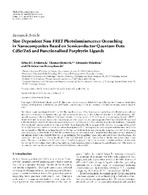| dc.contributor.author | Zenkevich, E. I. | en |
| dc.contributor.author | Blaudeck, T. | en |
| dc.contributor.author | Milekhin, A. | en |
| dc.contributor.author | Borczyskowski, C. von | en |
| dc.date.accessioned | 2017-05-27T11:12:57Z | |
| dc.date.available | 2017-05-27T11:12:57Z | |
| dc.date.issued | 2011 | |
| dc.identifier.citation | Size-Dependent Non-FRET Photoluminescence Quenching in Nanocomposites Based on Semiconductor Quantum Dots CdSe/ZnS and Functionalized Porphyrin Ligands / E.I. Zenkevich [et al.] // International Journal of Spectroscopy. Special Issue on Spectroscopic and Structural Insight into the Size-Dependent Behavior of the Nanophase. – 2011. – Vol. 2012. – P. 1-14. | en |
| dc.identifier.uri | https://rep.bntu.by/handle/data/30186 | |
| dc.description.abstract | We review recent experimental work to utilize the size dependence of the luminescence quenching of colloidal semiconductor quantum dots induced by functionalized porphyrin molecules attached to the surface to describe a photoluminescence (PL) quenching process which is different from usual models of charge transfer (CT) or Foerster resonant energy transfer (FRET). Steady-state and picosecond time-resolved measurements were carried out for nanocomposites based on colloidal CdSe/ZnS and CdSe quantum dots (QDs) of various sizes and surfacely attached tetra-mesopyridyl-substituted porphyrin molecules (“Quantum Dot-Porphyrin” nanocomposites), in toluene at 295 K. It was found that the major part of the observed strong quenching of QD PL in “QD-Porphyrin” nanocomposites can neither be assigned to FRET nor to photoinduced charge transfer between the QD and the chromophore. This PL quenching depends on QD size and shell and is stronger for smaller quantum dots: QD PL quenching rate constants kq scale inversely with the QD diameter. Based on the comparison of experimental data and quantum mechanical calculations, it has been concluded that QD PL quenching in “QD-Porphyrin” nanocomposites can be understood in terms of a tunneling of the electron (of the excited electron-hole pair) followed by a (self-) localization of the electron or formation of trap states. The major contribution to PL quenching is found to be proportional to the calculated quantum-confined exciton wave function at the QD surface. Our findings highlight that single functionalized molecules can be considered as one of the probes for the complex interface physics and dynamics of colloidal semiconductor QD. | en |
| dc.language.iso | en_US | en |
| dc.title | Size-Dependent Non-FRET Photoluminescence Quenching in Nanocomposites Based on Semiconductor Quantum Dots CdSe/ZnS and Functionalized Porphyrin Ligands | en |
| dc.type | Article | ru |
| dc.identifier.doi | 10.1155/2012/971791 | |

